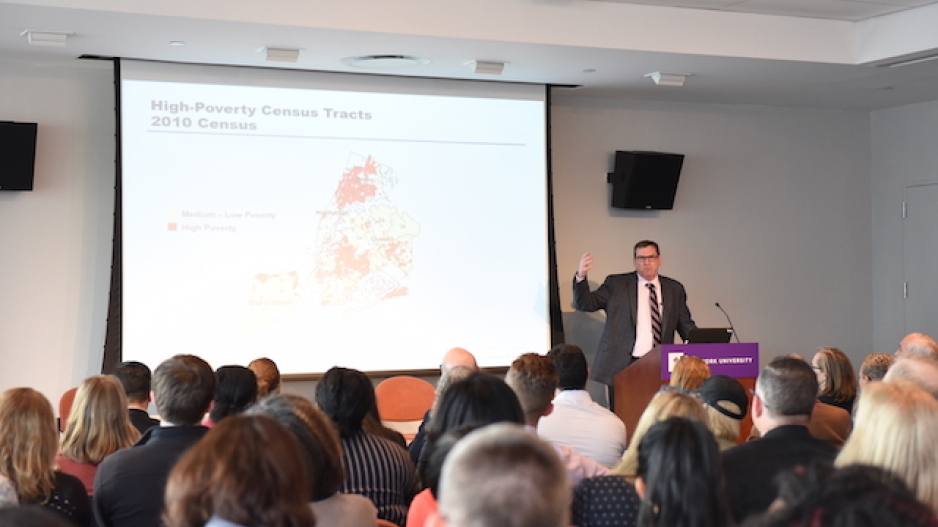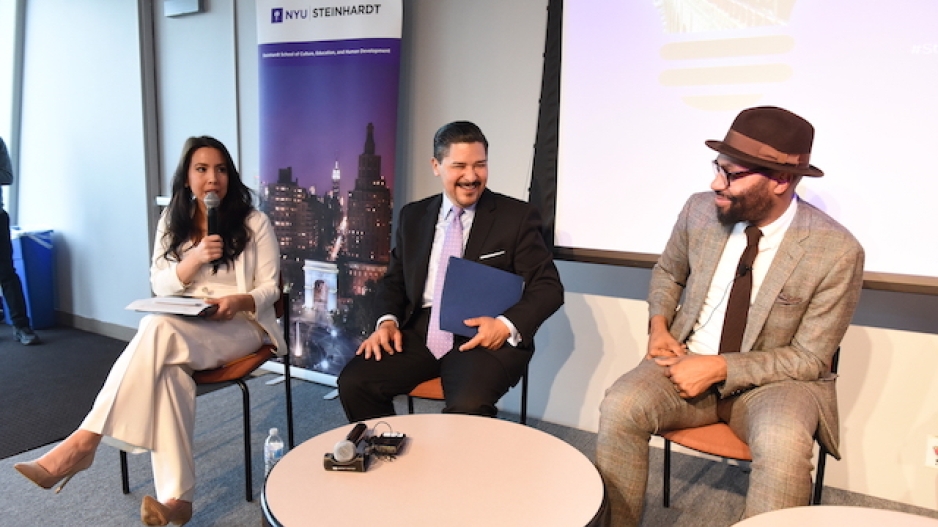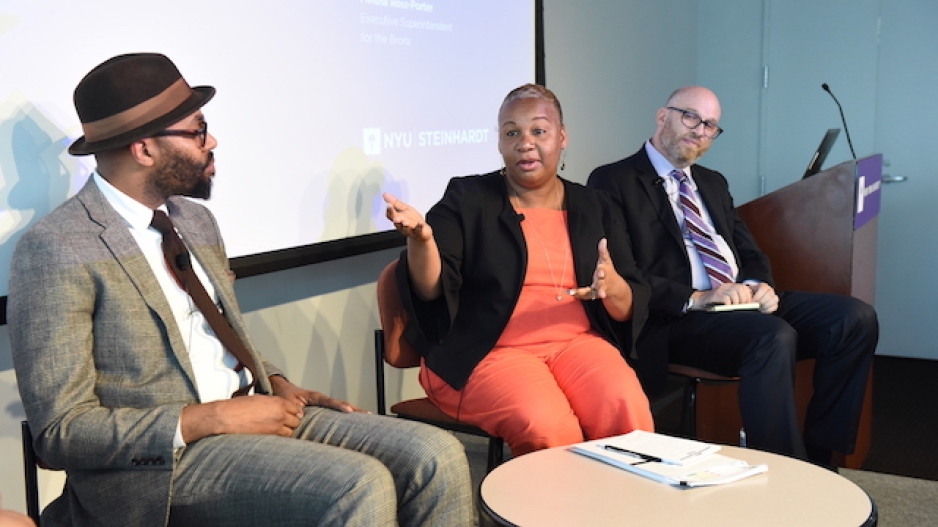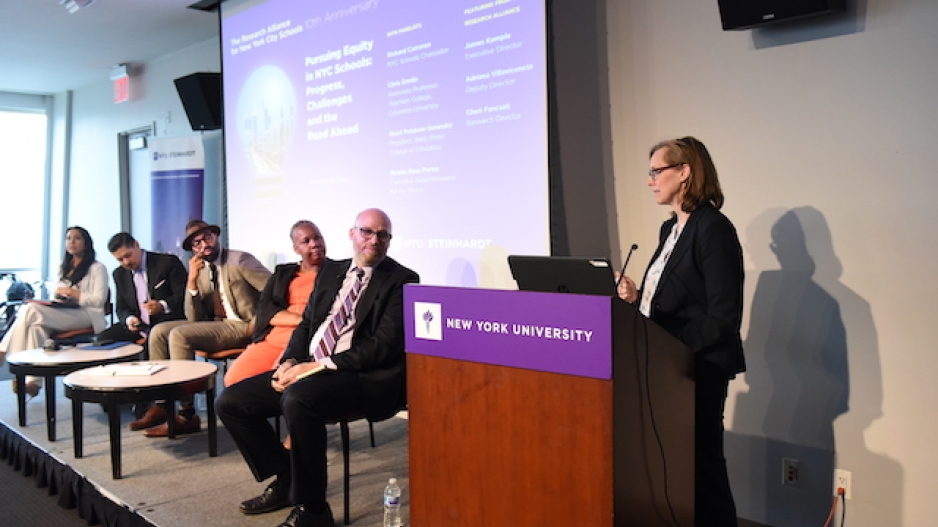On April 29, 2019, in recognition of the Research Alliance’s 10th anniversary, we convened an event to reflect on areas of progress, as well as persistent challenges facing the City’s public education system. About 200 educators, CBO staff, funders, scholars, and school and district leaders joined us for a presentation of new work by Research Alliance Executive Director James Kemple, followed by an invigorating panel discussion, moderated by Deputy Director Adriana Villavicencio and featuring:
- NYC Schools Chancellor Richard Carranza,
- Columbia Teachers College Professor Chris Emdin,
- Bank Street College President Shael Polakow-Suransky, and
- Executive Superintendent for the Bronx Meisha Ross Porter.
Kemple’s presentation highlighted steady improvement during the last two decades across a number of key student outcomes, including:
- Large increases in NYC’s high school graduation rate (from 54% in 2004 to 80% in 2018—meaning 23,000 more students are earning a high school diploma each year);
- Decreases in dropout rates and transfers out of the system;
- Increases in college enrollment and persistence;
- Upward trends in achievement in the elementary and middle grades; and
- Improved attendance (translating to about five extra days of school per year for every NYC student).
Kemple’s work also examined the persistence of educational inequalities, particularly along lines of race and ethnicity. Among his findings:
- Disparities in high school graduation rates have narrowed slightly, but continue (in 2018, for example, around 75% of Black and Latino students graduated on time, compared to about 90% of White and Asian students).
- Gaps in college enrollment are even larger.
- Disparities in ELA and math test scores have increased as standards have risen.
- Rates of chronic absenteeism are twice as high among Black and Latino students compared with their White and Asian peers.
- Kemple noted similar patterns of disparity for other groups, including those defined by gender, disability status, English learner status, housing status, family income, and residential community characteristics.

The panel discussion that followed Kemple’s presentation highlighted a number of important themes and directions for future policy, practice and research, which we summarize below.
Think Critically About How to Measure Success
As the panel discussion opened, Chancellor Carranza pointed out that while the amount of growth that NYC has experienced on these indicators is unusual, the racial disparities are not—similar patterns can be seen in other cities. The four panelists expressed that recognizing and addressing these inequities is essential, but they cautioned against treating students like “the problem,” emphasizing that the problem lies instead with the systems and structures that are intended to support students’ success.
Several panelists noted the limitations of current measures used to assess student and school performance, particularly state test scores and graduation rates. They called for more qualitative approaches that would elevate student voices and illuminate their lived experiences in schools and classrooms. Emdin and Porter suggested holding focus groups with diverse groups of students and parents across the City. Suransky mentioned portfolio models that use collections of student work to assess learning. All panelists stressed the importance of measuring skills that students need to succeed in college and the labor market.

Focus on Adults
Much of the panel discussion centered around the need to build adults’ capacity to effectively connect with and support students, starting from the earliest ages. Suransky noted that, with learning disparities already evident by age 2, investing in early childhood education (including infant and toddler care) is critical. He also observed that a school’s “model for adult learning predicts the model for student learning”—arguing that when schools are organized in ways that are explicitly democratic and collaborative, this translates to more effective classroom practices.
Executive Superintendent Porter and Chancellor Carranza also emphasized the importance of collaboration—both within schools and between schools and communities. They discussed the new Bronx Plan as an example. (The plan will provide incentives to teachers in hard-to-staff schools and embrace a collaborative approach to assessing problems and developing solutions.)
Professor Emdin emphasized the need to focus on effective, inclusive pedagogy. He expressed enthusiasm about “counselor-informed teaching” that integrates therapeutic practices and incorporating more “movement and orality” in classrooms. He advocated for a “reality-based pedagogy” that connects with students in deep ways and supports their social and emotional learning. He also argued for dismantling the myth that high standards and culturally relevant instruction are mutually exclusive—stressing that “we want high standards and inclusive pedagogy.”
The conversation raised important questions about teacher training. How can we prepare educators to be “deeply attuned to students” and to better support their learning and social and emotional development? Panelists called for giving would-be teachers more authentic, practical experience in classrooms, though apprenticeship models, for instance. It was noted that better training might “pay for itself” in the form of reduced teacher turnover.

Draw on Local Assets
Recognizing and leveraging assets in the communities where students live and go to school also emerged as important themes. Chancellor Carranza highlighted the inherent strengths of multilingual learners and their families, while Porter talked about “developing teachers to value their communities.” Emdin argued that “good teaching is localized,” and urged researchers and district leaders to seek out, nurture, and learn from “promising pedagogy happening in isolation.” Suransky suggested looking for lessons in the City’s effective small high schools.
The panel also touched on school segregation, which has been the focus of increasing public attention in recent months. The Chancellor emphasized that while desegregation matters (“it’s time”), it isn’t a panacea—and, furthermore, that “black and brown children don’t have to learn next to white children to be successful.” As Porter put it, “We live in a segregated City… I should have a great school on my block in the Bronx and not have to travel to get to one.” All the panelists agreed that what happens inside schools, in terms of pedagogy, relationships, resources, and so forth, is a crucial part of the desegregation discussion.

Next Steps
Research Director Cheri Fancsali closed out the event with a summary of major themes from the panel conversation. Her remarks reaffirmed the Research Alliance’s commitment to conducting research that actively informs policy and practice. To this end, she said the Research Alliance will continue to engage in discussions like this one, in a variety of settings, to inform the development of new studies and to encourage the use of research evidence.

With time running short, the panel was only able to take two questions from the audience, but many important topics were raised in the note cards that audience members submitted, including:
- How can we ensure that all students with disabilities receive needed services?
- How can we more effectively support English learners / multilingual learners?
- How can we make sure that schools are using evidence-based best practices to help struggling readers?
- Is there a role for a more defined and prescriptive curriculum to build on progress and close achievement gaps?
- How can we prepare teachers to use technology critically and effectively—and help students to do the same?
- What can be done—at a system level—to support the kind of instruction/pedagogy that the panelists have called for?
- What can parents and local communities do to move the equity agenda forward?
The Research Alliance team looks forward to continuing to engage with NYC’s diverse education stakeholders about these and other important questions for policy, practice and research. If you would like to share your perspectives, please connect with us on Twitter.

